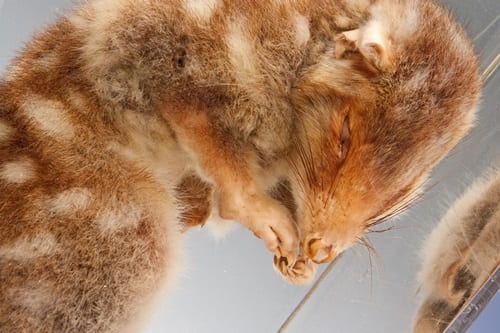Specimen of the Week 283: The Eastern Quoll
By Jack Ashby, on 17 March 2017
Mongooses, ferrets, shrews, meerkats, otters, weasels and cats: These are animals that most people will be familiar with.
Planigales, ningauis, kalutas, dunnarts, mulgaras and quolls: Not so much.
Despite all being small mammals, strangely named, absurdly cute (the second set even more so than the first), objectively interesting in many ecological, behavioural and evolutionary ways, there seems to be a difference in the level of attention between these groups of animal. The latter are all Australian marsupials, and for undoubtedly complicated political, colonial and egotistical reasons embedded in the western psyche, they don’t get their fair share of the limelight*. This week’s Specimen of the Week is a tiny step in addressing that, with…
**The Preserved Eastern Quoll**
Lazy naming
Quolls – along with everything else in the second list above – are Australasian carnivorous marsupials, belonging to the group Dasyuridae – the only slightly famous members of which are the Tasmanian devils (thanks, Warner Bros.). Despite being rather diverse in their own – there are around 70 species of dasyurid – they are often referred in terms of how they are apparently reminiscent of European species (even by Australians): most are dismissively called “marsupial mice”, even though – being carnivores or insectivores – they aren’t ecologically similar to mice at all.
Similarly quolls get called “native cats”, even though they aren’t at all cat-like: they have long slinky bodies but rather short legs – “marsupial mongoose” would be much more appropriate (in fact, the species name of the eastern quoll – Dasyurus viverrinus – means “ferret-like hairy-tailed”, which would seem to agree with that assessment). But really, there’s no need to relate them to any animal Europeans are more familiar with – as much as that is historically common practice – as they are on very distant branches of the mammal family tree and deserve recognition in their own right.
Quantity and Quollity
Being marsupials, eastern quolls embryos only spend a short period in the womb – around three weeks. They give birth to around 30 tiny “jelly-beans”, but following the arduous crawl to the pouch, only six babies can survive, as female quolls only have six teats. The pouch-young can’t share, as they have to do their growing permanently attached to the teat for around ten weeks, before being left in a den. I’ve encountered a number of quolls with large pouch-young. At the later stages of their lives in the pouch they are so big that much of their bodies hang out, and the mother has to walk on tip-toes to stop them being dragged along the ground.
Fox food
Eastern quolls today are only found in Tasmania, though up until the 1960s they also lived in the southeast of mainland Australia. Sadly they were victims of introduced cats and foxes there (foxes are yet to gain a proper foothold in Tasmania, but this appears to be changing).
Tasmania is also home to the larger (and somehow more handsome) spotted-tailed quoll, and two other quoll species live tentatively on the mainland, and a further two in New Guinea. I’ve grown very fond of this group of marsupials from my fieldwork:
We caught Wallace the spotted-tail #quoll 10 times in 10 days, inc twice in one day #mammalwatching #wildoz #tasmania pic.twitter.com/Y4XOOxOkjg
— Jack Ashby (@JackDAshby) October 10, 2014
Dangerous diets
This species nocturnally hunts small mammals, birds, insects, lizards and small snakes, as well as eating soft fruit. They also are avid scavengers, and appear to benefit from living on the same island as their Tasmanian devil cousins – who cut through the tough skins of prey animals during their own feeding, making it easier for the daintier quolls to get to the flesh. Scavenging in this way can be a dangerous living: the prevalence of squashed animals on the roads tempts scavengers to feed in the middle of the highway, so quolls and devils often fall victim to passing cars.
Devil in the detail
Eastern quolls underwent a huge population decline during the first decade of the 2000s, and are showing no signs of recovery. It was assumed that this was related to the fact that Tasmanian devil populations had crashed due to Devil Facial Tumour Disease – a transmissable cancer (you can read about fieldwork I’ve undertaken related to this on previous posts). In the absence of devils, it was assumed that cats had been able to rapidly increase in number, and that predation by cats was responsible for the quoll’s demise. A recent study, however didn’t find a link between cat increases and devil decreases (though they did find that cats are becoming more nocturnal in the absence of devils, which could bring nocturnal quolls into their firing lines). Instead, it is understood that eastern quolls initially suffered from a period of sustained bad weather, but cats are now preventing the low-density quoll populations from recovering by eating their young.
*except on here the Grant Museum blog – I rarely talk about anything else.
Jack Ashby is the Manager of the Grant Museum of Zoology
 Close
Close



